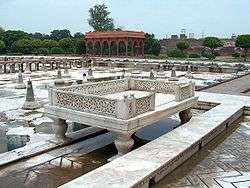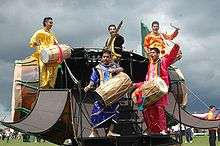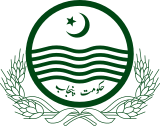Punjabi culture
The culture of the Punjab encompasses the spoken language, written literature, cuisine, science, technology, military warfare, architecture, traditions,sacrifices, values and history of the Punjabi people native to the northern part of the Indian subcontinent. The term 'Punjabi' can mean both a person who lives in Punjab and also a speaker of the Punjabi language. This name originates from the Persian language 'panj', (five), and 'ab', (water). Panjab or Punjab: land of the five rivers. Indus River (the largest river in this five river system), and the five other rivers to the south eventually join Indus or merge into it later in the downstream of the Punjab valley. All the rivers start and flow out of the Himalayas. These other five rivers are Jhelum River, Chenab River, Ravi River, Beas River and Sutlej River.
| Part of a series on the |
| Punjabis |
|---|
 |
|
|
Asia
Europe North America Oceania |
|
Culture |
|
Punjab portal |
History
Middle Ages
The culture of Punjab in the Middle Ages was extremely diverse dependent upon an individual's caste, community, religion and village . An array of cultures can be found historically .The main cultures that arose in the Punjab during the Medieval Age at the beginning of this era was of strong Indo-Aryan dominance.

Modern era
Due to the large number of Punjabi people distributed throughout the world, especially Pakistan and India, many people are increasingly experiencing the culture and becoming influenced by it. Glimpses of traditional Punjabi culture can be seen in the Western world (e.g. the U.S., the UK, the EU, Canada, Australia, Africa and the Middle East).[1] Naturally people influence each other wherever they settle and live. Punjabi culture is evident from Punjabi philosophy, poetry, spirituality, education, artistry, music, cuisine, and architecture.
Similar migrations by or invasions into the Punjab, in the past many centuries, were by the Aryans, Dravidians, Scythians, Portuguese, Spaniards, Armenians, Greeks or Alexander the Great which reached as far as the Beas River in the Punjab , Mongols Arabs, Persians, Afghans, Turko-Persians (Mughals) and then the Europeans (British) came to Punjab for various economic reasons of their own and its fertile agricultural lands and abundance of water resources in its five large rivers flowing down from the Himalayas through the Punjab valley. These immigrants influenced the people of Punjab and, in turn, were influenced by the then prevailing culture of the Punjab.[2]
Music

Bhangra is one of the many Punjabi musical art forms that is increasingly listened to in the west and is becoming a mainstream favourite.[3] Punjabi music is used by western musicians in many ways, such as mixing it with other compositions to produce award-winning music. In addition, Punjabi classical music is increasingly becoming popular in the west.
Devotional songs are played by dhaddi jatha groups, with instruments like sarangi and dhadd drums.
Dance
Owing to the long history of the Punjabi culture and of the Punjabi people there are many dances, normally performed at times of celebration, including harvests, festivals and weddings. The particular background of the dances can be non-religious and religious. The overall style can range from the high energy "bhangra" men's dance to the more reserved "jhumar," the "gidha" women's dance and "Malwayi Gidha" is a form of dance can be performed by both men and women together.
Weddings
Punjabi wedding traditions and ceremonies are traditionally conducted in Punjabi and are a strong reflection of Punjabi culture. While the actual religious marriage ceremony among Muslims, Hindus, Sikhs, Jains, Buddhists and Christians may be conducted in Arabic, Urdu, Punjabi, Sanskrit, Hindi or Pali by the Qazi, Pundit, Granthi or Priest, there are commonalities in ritual, song, dance, food, and dress. The Punjabi wedding has many rituals and ceremonies that have evolved since traditional times.
Crafts
The city of Amritsar in the Punjab state of India is home to the craft of brass and copper metalwork done by the Thatheras of Jandiala Guru, which is enlisted on the UNESCO's List of Intangible Cultural Heritage.[4] Years of neglect had caused this craft to die out, and the listing prompted the Government of Punjab to undertake a craft revival effort under Project Virasat.[5][6]
Cuisine
Language and literature
The Punjabi language is written with the Gurmukhi alphabet in India and with the Shahmukhi alphabet in Pakistan. Approximately 130 million people speak the Punjabi language.[7] In Punjabi literature has three major Punjabi romantic epic poems based on folktales: Heer Ranjha by the poet Waris Shah (1722-1798), Sohni Mahiwal and Mirza Sahiban (sung by late Alam Lohar).[2] By the 10th century, many Hindu Nath poets were associated with earlier Punjabi works. Among the major Punjabi poets are Baba Fariduddin Ganjshakar (1179-1266), Baba Guru Nanak (1469-1539) and Bulleh Shah (1680-1757).
Dress
The traditional dress for Punjabi men is the kurta and tehmat, which is being replaced by the kurta and pajama, especially the popular muktsari style in India. The traditional dress for women is the salwar suit which replaced the traditional Punjabi ghagra. The patiala salwar is also very popular.
Festivals
Punjabis celebrate cultural, seasonal and religious festivals, which include Maghi, Mela Chiraghan in Lahore, Lohri, Holi, Baisakhi, Teeyan, Diwali, Dussehra, and Guru Nanak Jayant.
Architecture
Punjab is known for its beautiful Sikh architecture.[8]
Gallery
 Punjabi girl in traditional Lehenga
Punjabi girl in traditional Lehenga.jpg) Punjabi charkha
Punjabi charkha Punjabi girl in Salwar kameez
Punjabi girl in Salwar kameez Punjabi Turban
Punjabi Turban
See also
- Punjab Culture Day
- Punjab region
- Punjabi people
- List of British Punjabis
- Punjab (India)
- Punjab (Pakistan)
- List of Punjabi language poets
- Punjabi Cultural Society of Chicago
- Turban training centre
References
- "How Punjabi language is flourishing in France". Newseastwest.com. 2014-08-05. Retrieved 2017-02-27.
- "Punjabi facts, information, pictures | Encyclopedia.com articles about Punjabi". Encyclopedia.com. Retrieved 2017-02-27.
- Moreno, Jacqueline. "Bhangra conquering one dance move at a time". The Observer. Retrieved 2019-12-26.
- "UNESCO - Traditional brass and copper craft of utensil making among the Thatheras of Jandiala Guru, Punjab, India". ich.unesco.org. Retrieved 2019-07-01.
- Jun 22, Yudhvir Rana | TNN | Updated; 2018; Ist, 19:34. "Ignored for years, local craft may soon find place in luxury hotels | Amritsar News - Times of India". The Times of India. Retrieved 2019-07-01.CS1 maint: numeric names: authors list (link)
- "Alchemy of Art". The Indian Express. 2019-04-07. Retrieved 2019-07-01.
- "Punjabi language and the Gurmukhi and Shahmuhi scripts and pronunciation". Omniglot.com. Retrieved 2017-02-27.
- "Cheer for Sikh devotees! Indian Railways Sultanpur Lodhi station redeveloped with special facilities; details". The Financial Express. 2019-11-08. Retrieved 2019-12-26.
Other sources
- Wrestling in Punjab, documentary film on the history of wrestling in Punjab by filmmaker Simran Kaler.
- Quraishee 73, Punjabi Adab De Kahani, Abdul Hafeez Quaraihee, Azeez Book Depot, Lahore, 1973.
- Chopra 77, The Punjab as a sovereign state, Gulshan Lal Chopra, Al-Biruni, Lahore, 1977.
- Patwant Singh. 1999. The Sikhs. New York: Doubleday. ISBN 0-385-50206-0.
- Nanak, Punjabi Documentary Film by Navalpreet Rangi
- The evolution of Heroic Tradition in Ancient Panjab, 1971, Buddha Parkash.
- Social and Political Movements in ancient Panjab, Delhi, 1962, Buddha Parkash.
- History of Porus, Patiala, Buddha Parkash.
- History of the Panjab, Patiala, 1976, Fauja Singh, L. M. Joshi (Ed).
- The Legacy of The Punjab by R. M. Chopra, 1997, Punjabee Bradree, Calcutta.
External links
- Video about Punjab and Punjabi music from the Horniman Museum

